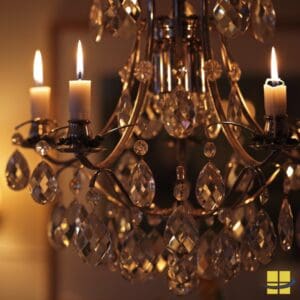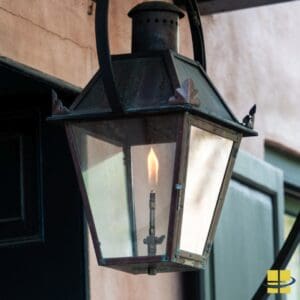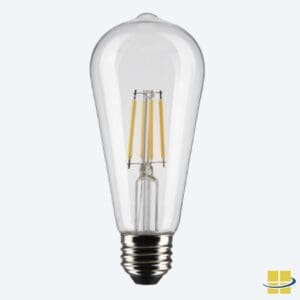
History of Lighting: From Ancient Flames to Modern Illumination
Lighting has been an integral part of human civilization, evolving through millennia from the simple flames used by our ancestors to the revolutionary electric light, including the incandescent light bulb invented by Thomas Edison, and the advanced LED technologies that illuminate our world today. This page provides an in-depth exploration of the key developments in the history of lighting, highlighting the major milestones that have shaped our journey from darkness to light.
Key Takeaways
-
-
Evolution Over Time: Lighting has progressed from simple flames to sophisticated LED technology, each advancement building on the previous.
-
Impact on Society: Innovations in lighting have significantly influenced productivity, safety, and quality of life.
-
Future Trends: Smart, sustainable, and human-centric lighting is shaping the future, making lighting more adaptable to human needs.
-
The Dawn of Lighting: Fire and Early Lamps (30,000 BC – 1000 AD)
There is evidence of man using controlled fire as long as 1.7 to 2.0 million years ago. The use of fire for illumination happened sometime between when man began to control fire and 30,000 BC. Using fire for light marked the first significant step in humanity’s ability to control and create light. The earliest forms of lighting were rudimentary, consisting of open flames used in fire pits and torches. As humans progressed, they began to seek more efficient and controlled lighting solutions.
Oil Lamps: The First True Lamps
Oil lamps represent one of the earliest advancements in lighting technology. Simple oil lamps, dating back to around 20,000 BC, were crafted from stones or shells with a bowl-shaped depression to hold animal fat or oil. A wick, often made from dried moss or plant fibers, was inserted into the fuel, drawing up the oil through capillary action and producing a small, controlled flame.
As pottery technology advanced, oil lamps became more elaborate, with enclosed reservoirs and defined places for wicks. These lamps were widely used across different civilizations, particularly in the Mediterranean, where olive oil and other plant-based oils were common fuels. The lamps provided a reliable source of light for both domestic and religious purposes, and their designs became increasingly sophisticated over time.
Candles: An Ancient Innovation
While oil lamps were predominant, candles also emerged as a significant lighting source. The first known candles were made in China around 200 BC, using whale fat. However, it wasn’t until the 1st century AD that tallow candles became widespread in Europe, especially in Roman times. These early candles were made from animal fat, particularly tallow from sheep or cows, and were often produced by traveling chandler guildsmen who crafted candles to order.
Candles became more common in Europe after the fall of the Western Roman Empire, when the disruption of the oil trade made candles a more accessible lighting option. By the 13th century, candles were a fixture in households across Europe, with beeswax candles being a luxury item reserved for the wealthy due to their clean-burning properties.


The Age of Innovation: Advancements in Lighting (1000 AD – 1800 AD)
The period between 1000 AD and 1800 AD saw significant advancements in lighting, driven by the discovery of new materials and the development of more efficient lighting methods.
Chandeliers and Sconces: Lighting for the Wealthy
As architectural designs evolved, so did the need for more elaborate lighting solutions. Chandeliers, first used in medieval times, became a popular feature in the homes of the wealthy. These multi-tiered assemblies of candles or oil lamps were suspended from ceilings and could be lowered and hoisted on pulleys for easy lighting and maintenance. Chandeliers provided both illumination and a status symbol, often adorned with intricate designs and expensive materials.
In more modest settings, wall-mounted sconces and recessed shelves provided stationary lighting solutions that minimized fire hazards. These were essential in a time when open flames were the primary source of light, and fire prevention was a constant concern.

The Argand Lamp: A Revolution in Oil Lamps
The late 18th century brought about a revolution in oil lamp design with the invention of the Argand lamp by Swiss scientist Aimé Argand in 1780. The Argand lamp featured a hollow wick and a cylindrical chimney, which significantly improved airflow and combustion efficiency. This design produced a brighter and cleaner light compared to earlier oil lamps, making it the lamp of choice until the advent of kerosene lamps in the mid-19th century.
The Argand lamp’s success was further enhanced by the use of whale oil, which was found to be a particularly bright and clean-burning fuel. However, the reliance on whale oil also led to overfishing and the eventual decline of whale populations, prompting the search for alternative fuels.
The Industrial Revolution: Gas Lighting Takes the Stage (1800 AD – 1900 AD)
The Industrial Revolution was a period of rapid technological advancement, and lighting technology was no exception. The discovery and commercialization of gas lighting during this time marked a major shift in how people illuminated their surroundings.
This transition set the stage for the development of the electric lamp, which became a more appealing and practical option for households during the late 19th and early 20th centuries.
The Invention of Gas Lighting
The first significant breakthrough in gas lighting occurred in the late 18th century when William Murdoch, an employee of the Soho Foundry in Birmingham, England, began experimenting with coal gas as a lighting source. In 1792, Murdoch successfully illuminated his home in Cornwall with gas, and by 1802, the exterior of the Soho Foundry was lit by gas lamps, astonishing the local populace.
Gas lighting technology converts energy into visible light by burning gas, producing light through combustion. Gas lamps, or “gaslights,” quickly became popular for street lighting and in large interior spaces. The centralized gas supply eliminated the need for individual refilling, and the ability to meter gas usage made it a commercially viable solution. Gaslights provided a much brighter and more consistent light than oil lamps, and their introduction was particularly welcomed in theaters, where the enhanced lighting allowed for more natural performances.

The Spread of Gas Lighting
The success of gas lighting in public spaces led to its widespread adoption in homes and businesses. By the mid-19th century, cities across Europe and North America were installing gas lighting systems, transforming the urban landscape and extending the hours of productivity well into the night.
Gas lighting also had a significant impact on industrial production. Factories, once limited by the availability of daylight, could now operate around the clock under the bright glow of gas lamps. This increase in productivity was a key factor in the economic growth of the Industrial Revolution.
The Electric Age: From Arc Lamps to Incandescent Bulbs (1800 AD – 1900 AD)
The discovery of electricity and its application to lighting marked one of the most significant turning points in the history of lighting. The development of electric lighting technology unfolded over the course of the 19th century, culminating in the widespread use of incandescent bulbs by the century’s end. The invention of the electric light bulb by Thomas Edison revolutionized indoor and outdoor illumination, establishing electricity as the primary lighting source.
The 20th century saw further advancements in lighting technology, particularly with the development of high-intensity discharge (HID) lamps, which offered more energy-efficient solutions compared to incandescent lighting.
The First Electric Lights: Arc Lamps
In 1802, Humphry Davy, a British chemist and inventor, demonstrated the first arc lamp by passing an electric current through a strip of platinum, creating incandescence. Although this was a rudimentary form of electric lighting, it paved the way for future developments.
By the 1840s, arc lamps were being used to light public spaces in cities like Paris and London. These early electric lamps produced an intense, bright light that was far superior to gas lamps, but they were also more expensive and required a reliable source of electricity, which was not yet widely available.

The Incandescent Light Bulb: A New Era of Lighting
The quest for a practical and commercially viable incandescent light bulb involved numerous inventors across the world. In 1878, Thomas Edison began his work on the incandescent light bulb at his Menlo Park laboratory in New Jersey. After experimenting with various materials, Edison settled on a carbon filament, which provided reliable and long-lasting light.
Edison’s success in developing the incandescent bulb was not just in the bulb itself but in the creation of an entire lighting system. In 1882, he developed the first commercial power utility in lower Manhattan, demonstrating that it was possible to distribute electricity from a central generator to multiple buildings, thereby lighting entire city blocks.
This system, combined with the incandescent bulb, revolutionized lighting and set the stage for the widespread adoption of electric lighting in homes, businesses, and public spaces. However, the use of traditional incandescent light bulbs has declined as more energy-efficient alternatives, such as halogen and LED bulbs, have emerged.
The 20th Century: Fluorescent Lights and the Rise of LED Technology (1900 AD – Present)
The 20th century was marked by rapid advancements in lighting technology, driven by the need for more energy-efficient and longer-lasting lighting solutions. Fluorescent bulbs initially found their use in commercial settings, but advancements in their design and efficiency eventually made them viable for residential lighting.
Fluorescent Lighting: A New Form of Illumination
Fluorescent lighting emerged in the early 20th century as a promising alternative to incandescent bulbs. By the 1930s, fluorescent lamps were being developed and introduced to the market, offering a more energy-efficient light source with a longer lifespan. These lamps became especially popular during World War II, as energy conservation became a national priority.
Fluorescent lamps work by passing an electric current through a gas, typically mercury vapor, which emits ultraviolet light. This light then excites a phosphor coating on the inside of the tube, producing visible light. The development of rare-earth phosphors in the 1970s further improved the color quality and efficiency of fluorescent lamps, solidifying their place in commercial and industrial lighting.

The Invention of the LED: A Lighting Revolution
The invention of the Light Emitting Diode (LED) in 1962 by Nick Holonyak Jr. marked the beginning of a new era in lighting. Initially used in electronic displays and indicator lights, LEDs have since evolved into one of the most important lighting technologies of the modern era.
LEDs work by passing an electric current through a semiconductor material, which emits light. This process is highly efficient, producing more light and less heat than traditional incandescent bulbs. The development of high-brightness blue LEDs in the 1990s made it possible to create white light by combining blue LEDs with red and green phosphors, leading to the widespread adoption of LEDs in general lighting.
Today, LEDs are the preferred lighting solution in many applications, from residential lighting to large-scale commercial and industrial projects. They are prized for their energy efficiency, long lifespan, and versatility, with the ability to produce a wide range of colors and lighting effects.
The Future of Lighting: Emerging Technologies and Trends
As we move further into the 21st century, the future of lighting is being shaped by new technologies and trends that promise to make lighting even more efficient, sustainable, and adaptable to our needs.
Smart Lighting: The Integration of Technology and Lighting
One of the most significant trends in lighting today is the integration of smart technology. Smart lighting systems allow users to control their lighting remotely via smartphones or voice-activated assistants like Amazon Alexa or Google Home. These systems can adjust brightness, color temperature, and even the direction of light, creating customizable lighting environments that can enhance mood, productivity, and energy efficiency.
Sustainable Lighting Solutions
Sustainability is another major focus in the future of lighting. The development of more efficient LEDs and the use of renewable energy sources for lighting are key components of this trend. Solar-powered lighting, for instance, is becoming increasingly popular in both residential and commercial applications, providing an eco-friendly alternative to traditional electric lighting.
The Role of Human-Centric Lighting
Human-centric lighting is an emerging concept that considers the impact of light on human health and well-being. Research has shown that different lighting conditions can affect our circadian rhythms, mood, and overall health. As a result, lighting designers are increasingly focusing on creating lighting solutions that mimic natural light patterns, supporting our biological needs and enhancing our quality of life.
History of Lighting Conclusion: Lighting the Way Forward
The history of lighting is a story of innovation and progress, driven by humanity’s quest to harness and control light. From the flickering flames of ancient oil lamps to the cutting-edge LED technologies of today, each advancement in lighting has brought us closer to a world where we can create the perfect light for any situation, at any time of day or night.
As we look to the future, the possibilities for lighting are endless. With ongoing research and development, we can expect to see even more exciting advancements that will continue to illuminate our lives in ways we have yet to imagine.
History of Lighting Frequently Asked Questions (FAQs)
You have questions about the History of Lighting. We have answers. If you have a question that isn’t answered below, contact an Access Fixtures lighting specialist at (800) 468-9925 or click here.
When was fire first used for lighting?
Fire was controlled and used for lighting as early as 30,000 BC.
What are oil lamps, and when did they appear?
Oil lamps, using animal fat or oil for fuel, date back to 20,000 BC.
When were candles first invented?
The first known candles were made in China around 200 BC.
What is an Argand lamp, and why is it significant?
The Argand lamp, invented in 1780, improved airflow and combustion efficiency, providing a brighter light.
Who invented gas lighting, and when?
William Murdoch developed gas lighting in the late 18th century.
When did electric lighting first emerge?
Humphry Davy demonstrated the first electric arc lamp in 1802.
Who is credited with inventing the incandescent light bulb?
Thomas Edison developed a practical incandescent bulb in 1878.
What are fluorescent lamps, and when were they popularized?
Fluorescent lamps, introduced in the 1930s, became popular during World War II for their energy efficiency.
When was the LED invented?
The LED was invented by Nick Holonyak Jr. in 1962.
What is human-centric lighting?
Human-centric lighting designs light solutions that mimic natural patterns to support biological rhythms and well-being.
How did gas lighting transform urban areas?
Gas lighting extended work hours, improved nighttime visibility, and illuminated public spaces, significantly impacting productivity and city life.
Why were whale oil and tallow used in early lamps?
Whale oil and tallow were common fuels due to their availability and effectiveness in producing bright, steady flames.
What role did the Industrial Revolution play in lighting technology?
The Industrial Revolution facilitated the widespread use of gas lighting, transforming both public and private spaces.
How do LEDs differ from incandescent bulbs?
LEDs are far more energy-efficient, have a longer lifespan, and produce less heat compared to incandescent bulbs.
What are some modern trends in lighting technology?
Smart lighting systems, human-centric designs, and sustainable solutions like solar-powered lights are shaping the future of lighting.

